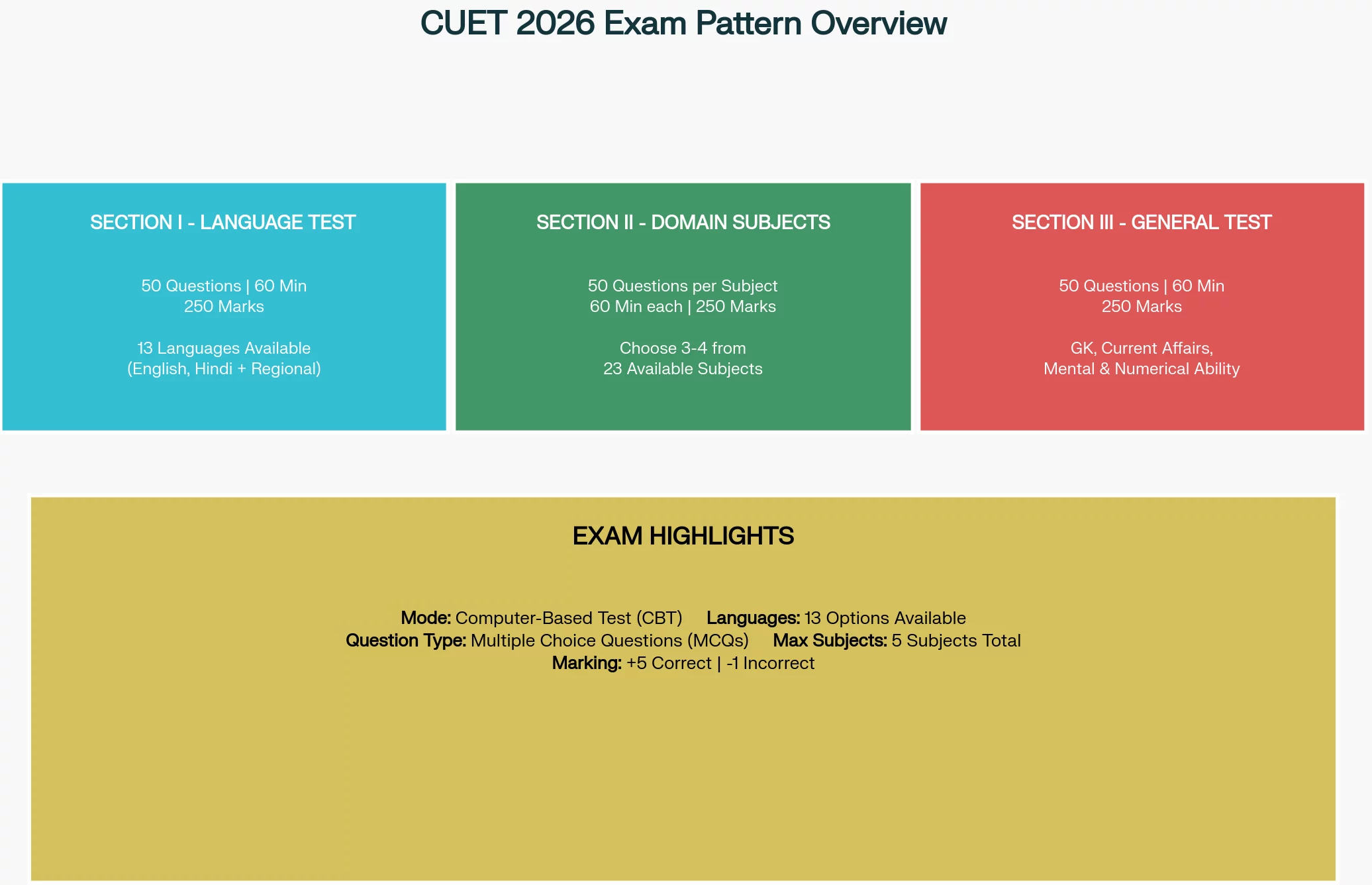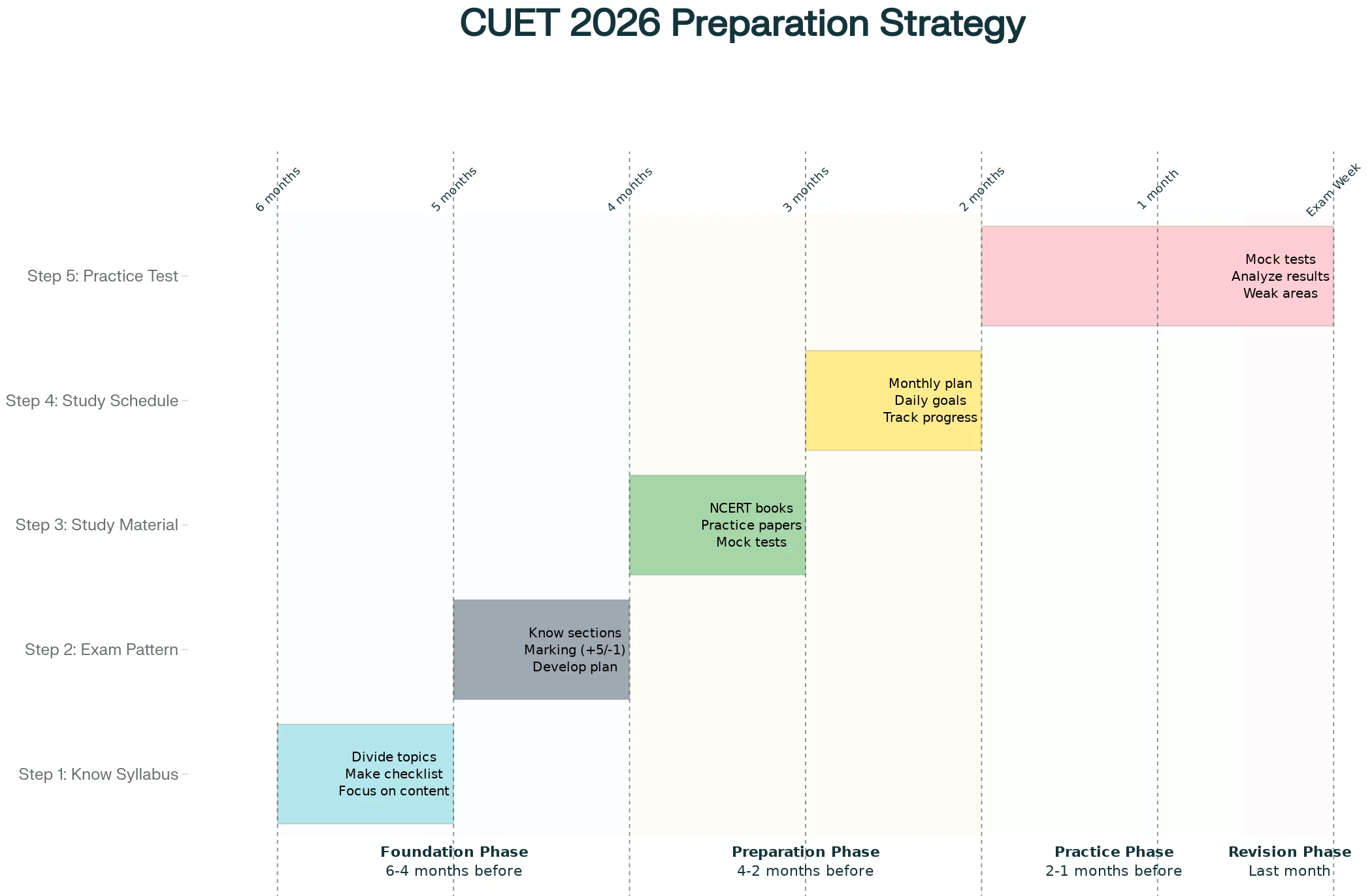CUET Exam Pattern 2026: Marking Scheme, Subjects, Marks & No. of Questions
The CUET exam pattern for 2026 consists of three sections: language test, domain-specific subject exams, and a general test. Each subject carries equal number of questions i.e. 50 questions worth 5 marks each. Candidates preparing for CUET UG must stay updated with the exam pattern.
The key aspects of CUET Exam Pattern:
- The CUET 2026 question paper will feature objective-type multiple-choice questions (MCQs).
- Candidates can take the exam in English or choose from 13 regional languages.
- Each question is valued at 5 marks, with a negative marking of one mark for every incorrect answer.
- Students can pick up to 5 subjects to focus on.
- The expected date of CUET exam 2026 is in the second week of May 2026.
CUET Exam Pattern 2026 – Highlights
If you’re preparing for CUET exam 2026, understanding its exam pattern is crucial. The CUET exam is divided into 3 sections: Language Paper, Domain Paper, and General Aptitude Test.
The CUET UG 2026 exam will be conducted in a Computer-Based Test (CBT) mode, featuring Multiple-Choice Questions (MCQ) format. Key highlights of the CUET exam pattern for 2026 are presented in the table below:
| Particulars | Details |
| Mode of Exam | Computer-Based Test (CBT) |
| Number of Slots | 3 to 4 slots per day |
| Exam Timing | Shift 1: 9 AM to 12 PM
Shift 2: 3 PM to 6 PM |
| Type of Questions | Multiple Choice Questions (MCQs) |
| Exam Sections | – Section I: Language- Section II: Domain Subjects- Section III: General Aptitude |
| Total Questions | 50 questions per subject |
|
Marking Scheme |
+5 for a correct answer -1 for an incorrect answer |
| Negative Marking | Yes |
| Medium of Examination | Available in 13 languages: English, Hindi, Assamese, Bengali, Gujarati, Kannada, Malayalam, Marathi, Odia, Punjabi, Tamil, Telugu, and Urdu |
| Number of Domain Subjects | 23 domain-specific subjects |
Read More: CUET Full Form
CUET 2026 Exam Pattern- Section Wise
The table below demonstrates the complete structure of CUET UG.
| Section | Number of Questions | Duration | CUET Exam Total Marks |
Type of Questions |
| Section I-A: Language | 50 Questions | 60 minutes (common for all subjects) | 250 | Reading comprehension based on various passage types: factual, literary, and narrative. Also includes vocabulary and language aptitude-based MCQs. |
| Section II: Domain Subjects | 50 Questions | 60 minutes (per subject) | 250 | MCQs derived from NCERT Class 12 syllabus – Questions may include text-based inputs |
| Section III: General Test | 50 Questions | 60 minutes | 250 | Covers General Knowledge, Current Affairs, Mental & Numerical Ability, Quantitative Reasoning, and Logical & Analytical Reasoning – Input-based MCQs included |
CUET Exam Pattern 2026: Section-wise Details
Here is a detailed exam pattern for CUET 2026:
Section 1- Languages:
In this Section of the CUET 2026, you can choose from a total of 13 languages, including Tamil, Telugu, Kannada, Malayalam, Marathi, Gujarati, Odia, Bengali, Assamese, Punjabi, English, Hindi, and Urdu.
The language test focuses upon the assessment of candidate’s proficiency skills in their chosen language. This section includes Reading Comprehension based on passages, and Grammar & Vocabulary. The test paper will be in the chosen language and won’t be bilingual.
Section 2 – Domain-Specific Subjects:
When selecting domain-specific subjects, candidates can pick from the CUET subjects without being limited to what they’ve studied in 12th grade. Candidates can choose subjects from a list of total 23 domain subjects and appear for 3-4 domain subjects. Such domain subjects vary from the test papers in section 1 & 3.
It’s recommended that candidates review the university’s brochure to make informed choices about these subjects. According to the CUET exam pattern for 2026, the domain-specific subjects are as follows:
- Accountancy/ Book Keeping
- Agriculture
- Anthropology
- Biology
- Business Studies
- Chemistry
- Computer Science/ Informatics Practices
- Economics/ Business Economics
- Fine Arts/ Visual Arts (Sculpture/ Painting)/Commercial Arts
- Geography/Geology
- Home Science
- History
- Knowledge, Tradition, and Practices of India
- Environmental Science
- Mathematics
- Physical Education/ NCC /Yoga
- Physics
- Political Science
- Psychology
- Sociology
- Mass Media/ Mass Communication
- Performing Arts
- Sanskrit
These domain subjects include questions based on the CUET UG exam pattern and syllabus given by NTA in MCQ format.
Section 3- General Aptitude Test:
CUET General Aptitude Test is an optional exam, depending on the university and course requirements that you choose. The questions are in MCQ format in the preferred language in section 1.
The questions are based on General Knowledge, Current Affairs, General Mental Ability, Numerical Ability, Quantitative Reasoning, Logical & Analytical Reasoning, and General Science & Environment Literacy.
Candidates have the option to select this section for discontinued subjects, Vocational/Open Eligibility, Cross Stream, or any other relevant UG courses. It is an optional section, and candidates can choose it based on the requirements set by the participating CUET university.
Read More: CUET DU Cutoff
CUET Exam UG Marking Scheme
The CUET exam has a total of 250 marks. Here’s how the marking scheme works according to the NTA:
- For a correct answer or the most suitable choice, you will get five marks (+5).
- If you select an incorrect option, you will lose one mark (-1).
- Questions that are unanswered or marked for review will score zero marks (0).
- If more than one option is correct, only those who chose one of the correct options will receive five marks (+5).
- If all options are correct, everyone who attempted that question will get five marks (+5).
- If none of the options are correct or a question is deemed wrong or dropped, all candidates who attempted that question will receive five marks (+5).
Read More: Here are more resources for you to understand the CUET Syllabus:
CUET UG 2026 Preparation: How to Prepare for CUET Exam
To excel in the CUET UG 2026 exam, you will need to dive into focused preparation. Your approach to studying for CUET should mirror how you prepared for your Class 12 Board exam. Allocate time for language subjects and the General Test if you plan on taking it. Here’s how to prepare effectively for CUET UG 2026:
1. Know the CUET Syllabus Inside Out
Go through the CUET UG 2026 syllabus carefully before you start. One must divide subjects into smaller topics and make a progress checklist. Never waste your time on irrelevant areas and focus only on what’s in the syllabus.
2. Understand the Exam Pattern and Marking Scheme
Make sure you understand the CUET exam pattern 2026 and marking scheme to develop a solid game plan. This involves knowing the number of sections, question types (like multiple-choice or essay), exam duration, and how marks are allocated for correct and incorrect answers.
3. Use the Right Study Material
One must gather recommended textbooks, guides, and CUET practice papers. Solve as many previous years’ question papers as possible to identify recurring topics and difficulty levels. Supplement your learning with online mock tests and sample questions from trusted sources.
4. Make a Smart Study Schedule
Create a monthly study timetable that covers all subjects and leaves room for revision. Begin with setting up realistic daily goals and track your progress visually. Keep your schedule flexible to adjust for revisions or extra practice.
5. Practice, Test, and Analyze
Attempt CUET mock tests regularly to simulate the real exam. Practice under timed conditions to improve speed and accuracy. After every test, analyze your performance to spot weak areas and refine your strategies.
FAQs
How many marks is the CUET exam for?
The total marks for the CUET exam is 250 marks per subject. Each subject has 50 questions which is worth 5 marks each.
Can I crack CUET without coaching?
Yes, it’s possible to qualify the CUET exam without coaching, only if you are very-well aware about the CUET exam pattern and its syllabus. It’s recommended to have the right strategy along with the right guidance and mock tests. The CUET mock tests allow you to get familiar with the real exam situation and get confident.
What is the CUET cutoff?
Based on the previous year’s cutoffs analysis the CUET cutoffs for the top-tier colleges are between the range of 99 and 97.5 percentile. Colleges like Moti Lal Nehru had a cutoff of 98.5-99 for BA course and 97-99 for BSc. Ramjas College had a cutoffs of 99 to 98. You can check here the complete list of Delhi University CUET cutoffs and target your desired college for 2026 CUET exam.
How many times can I attempt CUET?
There is no cap on the number of CUET attempts. One can appear for CUET UG exam for unlimited times. You only have to fulfill the CUET eligibility criteria for the various Universities.







